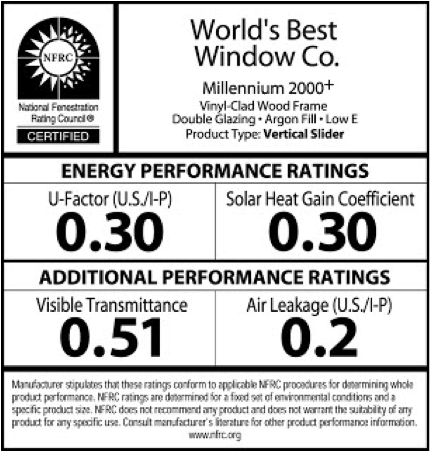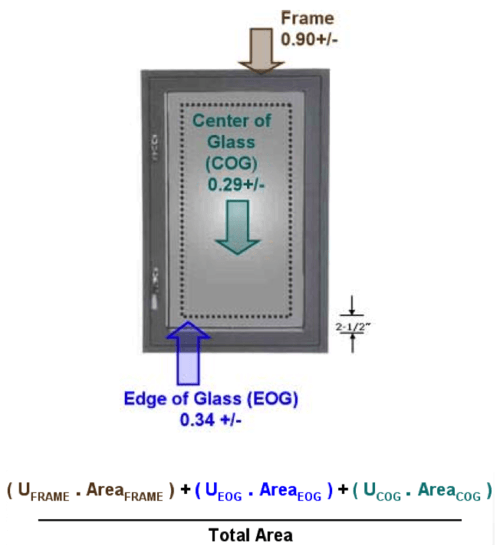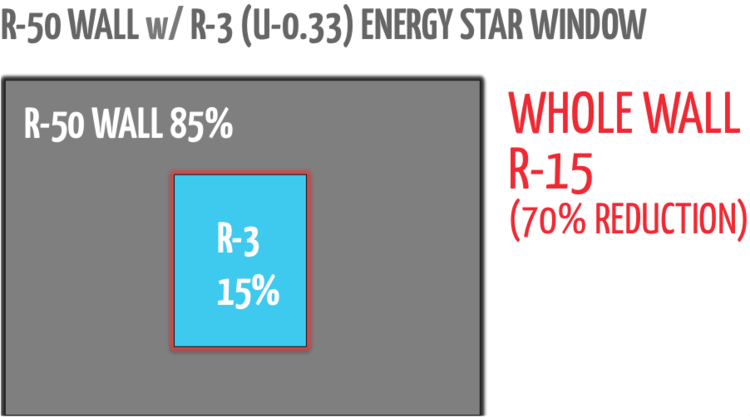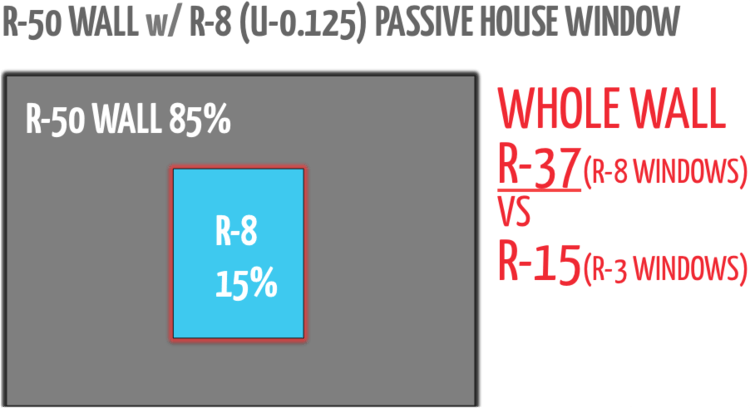High Performance Windows
For the most comfortable building possible, high performance glazing is mandatory.
High performance windows are an extremely critical part of high performance building design. Without them, buildings experience excessive heat loss, increased air leakage, and cold interior surface temperatures. All of which cause uncomfortable interior conditions, costly utility bills, and long term durability issues.
To understand why high performance windows are so awesome, we must first understand the basics of window science.
Windows bring daylight into your buildings and offer views to the exterior - obviously. This is a very import element of design and interior comfort of the occupants. After all, no one likes a dark room, and people usually love a view. Next, windows can allow fresh air into our buildings when opened. Many times of the year, we don’t need to have our ventilation system on, and can instead open windows for our fresh air. Finally, windows allow solar heat energy to enter into our buildings. During the wintertime, this solar heat is very welcome. During the summertime, we have the potential to overheat and cook. Windows also allow a lot of heat out of our buildings – tremendous amounts!
Overall, we must be very thoughtful with our window design in high performance buildings in order to get the right mix of solar gains, heat losses, daylighting, and views. These all must be accounted for in our window design. More often than not, in low performing buildings, heat loss, solar heat gain, and daylight are never thought about. Designing for views has never been an issue with designers. However, strictly focusing on the ‘view,’ often results in overheating, cold walls, and dark rooms. We can do better.
It's all in the performance specifications!
Several performance specifications are significant to understanding the basics of window science. Below is an example of a NFRC (National Fenestration Rating Council) window performance specification sheet. These sheets are important because they allow windows to be directly compared – apples to apples. Although the sheet claims ‘World’s Best Window Co.,’ please do not be fooled. The world’s best window manufacturers would sooner step on a nail before producing a window with these specifications. You will soon understand why.
An example of a NFRC window fact sheet
U-Value
Window manufacturers will either tell you the U-value, or the R-value of their window. U-value is just the inverse of R-value (R-value = 1/U-value), so don’t be confused with that. Europeans like to talk U-value because it is the actual number to calculate heat transfer. North Americans prefer to talk in R-value because we like big numbers. It just wouldn’t sound right if we said our R-8 window was U-value 0.125. The important thing to understand, higher R-value is good, lower U-value is good. In this fact sheet, this window would be a R-3.33 (1/U-value 0.3 = R-3.33). That is not a high performance window.
This image and description represents how the overall U-value of the window is calculated by the NFRC. This is very important to understand, so you do not misunderstand your performance specifications!
Center of glass
The center of glass portion of the window is the best performing, or has the lowest U-value (or highest R-value). Some window manufacturers will only report this number because it is the most appealing performance number to market. This is only useful marketing to the untrained consumer (but since you are no longer the untrained consumer, you will not be misled by such marketing tactics).
Edge of glass
The edge of glass will allow more heat transfer than the center of glass. The edge is considered to be the outer 2 ½” of the glazing, all the way around the window. In low quality windows, you will often see this portion of the window fog up with condensation, or even have frost in extreme cold. This is because the edge allows for more heat transfer, and the surface temperature is lower compared to the rest of the window, allowing for condensation to form. High performance windows do not have low temperature edge values.
Frame
The frame represents the largest portion of heat transfer through the whole window. Low quality windows will have aluminum spacers around the entire window. Aluminum is extremely conductive, basically a highway of heat loss around the window. Again, low quality windows have this, and you will often see this portion have condensation or even frost in extreme cold. This leads to durability issues and interior comfort problems.
Installation
Installation is not included in how the NFRC calculates the overall U-value of the window because everyone has a different installation design. Yes, how we install the window into our wall makes a big difference in our overall U-value of the window, up to a 20% difference! The best place to place a window to minimize heat loss is in the middle of the thermal insulation layer. Not on the outer edge with the cladding, and not on the inner edge with the gypsum, but right in the middle. Next step is to place insulation over the window frame. This is the best way to optimize the energy performance of your windows.
Check out good examples of over insulating window frames at Zola and Alpen.
Acoustics
We cannot forget about sound. Sound transmission is measured with an STC, also know as Sound Transmission Class. The higher the value, the more overall sound it will stop from transmitting through the window. High performance windows by their very nature of design are a vast improvement from low quality windows because of their superior air tightness, more panes of glazing, and insulated frames. It is remarkable, the acoustical difference between a high performance window compared to a typical window.
Solar heat gain coefficient
Also know as SHGC is very important performance characteristic of windows. It is a representation of the amount of solar energy that can be transferred through the window. If a window has a SHGC of 0.55, it will allow 55% of the solar energy through it. In the fact sheet, it lists a SHGC of 0.3, thus allowing 30% of the solar energy through the window. Low-E windows, or low emissivity windows, have low SHGC values. The desired level of SHGC will vary depending on your building design and orientation. Is it very important to understand – the higher the SGHC for the window, the lower the R-value of the window. We cannot have both, although high performance Passive House windows will have more favorable ratios, which is another reason why we love them. As a good rule of thumb: SHGC of around 0.5 – 0.6 for southern exposure, and then low SHGC for the rest of the orientations.
Visual transmittance
This is the measurement of the amount of visual light that comes through the window. It is a scale from 0.0 – 1.0. In the fact sheet above, the visual transmittance is rated as 0.51. This means that 51% of the visual light is transmitted through the window and into the interior space. Windows with low SHGC will usually have lower visual transmittance values because of additional layers of films that are placed on the glass. These films are the ‘low-e’ coatings that reflect radiant heat transfer. The visual transmittance value does not directly affect heat loss/gain, but is strictly a measure of the amount of daylight allowed through the window.
Air leakage
The amount of air leakage through our windows is an important characteristic. The lower the air leakage number, the better the window. (See Airtight Construction for more info.) Not all manufacturers will display this number because they are not required. This number can vary depending on the type of window as well. For example, a double hung will likely leak more than a casement. There are more seams, cracks, and openings to seal. This is a big difference between high performance Passive House windows and the rest. Passive house certified windows undergo more rigorous testing to ensure that air seals are tighter.
You are now well informed about the performance criteria of windows and the basics of the science behind them!
Please, give me more R-value!
The following two Images clearly outline the main reason why we need high performance windows. This is a very big deal!
Image 3: R-50 Wall with R-3 Window (Source: Sam Hagerman, Thermal Bridge Free Construction)
Image 4: R-50 Wall with R-8 Window (Source: Sam Hagerman, Thermal Bridge Free Construction)
Images 3 and 4 above outline the first reason why we need high performance windows. If we take our true R-50 wall, and have 15% glazing with a R-3 energy star window, the overall R-value of the wall is reduced to R-15. That’s a massive 70% reduction of our assembly’s performance. Next, an R-8 Passive House window is used instead, and we are reduced down to a R-37, a 26% reduction in overall R-value. Yes, R-value is a big deal, especially when we are dealing with windows. Going from an R-3 to an R-8 is a thermal resistance improvement of 63%, and the additional cost is 10-30%, depending on our manufacturer. Windows are definitely not a line item you want to cheap out on. For the most comfortable building possible, high performance glazing is mandatory.
For more information about window design and placement, see Site Orientation.








